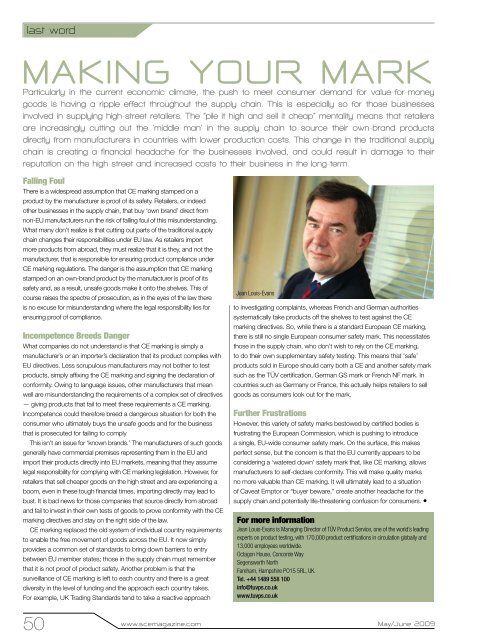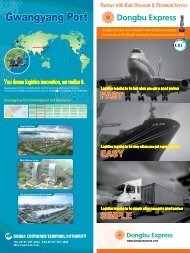w w w . s c e m a g a z i n e . c o m - Supply Chain Europe
w w w . s c e m a g a z i n e . c o m - Supply Chain Europe
w w w . s c e m a g a z i n e . c o m - Supply Chain Europe
You also want an ePaper? Increase the reach of your titles
YUMPU automatically turns print PDFs into web optimized ePapers that Google loves.
last word<br />
Making your Mark<br />
Particularly in the current economic climate, the push to meet consumer demand for value-for-money<br />
goods is having a ripple effect throughout the supply chain. This is especially so for those businesses<br />
involved in supplying high-street retailers. The “pile it high and sell it cheap” mentality means that retailers<br />
are increasingly cutting out the ‘middle man’ in the supply chain to source their own-brand products<br />
directly from manufacturers in countries with lower production costs. This change in the traditional supply<br />
chain is creating a financial headache for the businesses involved, and could result in damage to their<br />
reputation on the high street and increased costs to their business in the long-term.<br />
Falling Foul<br />
There is a widespread assumption that CE marking stamped on a<br />
product by the manufacturer is proof of its safety. Retailers, or indeed<br />
other businesses in the supply chain, that buy ‘own brand’ direct from<br />
non-EU manufacturers run the risk of falling foul of this misunderstanding.<br />
What many don’t realize is that cutting out parts of the traditional supply<br />
chain changes their responsibilities under EU law. As retailers import<br />
more products from abroad, they must realize that it is they, and not the<br />
manufacturer, that is responsible for ensuring product compliance under<br />
CE marking regulations. The danger is the assumption that CE marking<br />
stamped on an own-brand product by the manufacturer is proof of its<br />
safety and, as a result, unsafe goods make it onto the shelves. This of<br />
course raises the spectre of prosecution, as in the eyes of the law there<br />
is no excuse for misunderstanding where the legal responsibility lies for<br />
ensuring proof of compliance.<br />
Incompetence Breeds Danger<br />
What companies do not understand is that CE marking is simply a<br />
manufacturer’s or an importer’s declaration that its product complies with<br />
EU directives. Less scrupulous manufacturers may not bother to test<br />
products, simply affixing the CE marking and signing the declaration of<br />
conformity. Owing to language issues, other manufacturers that mean<br />
well are misunderstanding the requirements of a complex set of directives<br />
— giving products that fail to meet these requirements a CE marking.<br />
Incompetence could therefore breed a dangerous situation for both the<br />
consumer who ultimately buys the unsafe goods and for the business<br />
that is prosecuted for failing to comply<br />
This isn’t an issue for ‘known brands.’ The manufacturers of such goods<br />
generally have commercial premises representing them in the EU and<br />
import their products directly into EU markets, meaning that they assume<br />
legal responsibility for complying with CE marking legislation. However, for<br />
retailers that sell cheaper goods on the high street and are experiencing a<br />
boom, even in these tough financial times, importing directly may lead to<br />
bust. It is bad news for those companies that source directly from abroad<br />
and fail to invest in their own tests of goods to prove conformity with the CE<br />
marking directives and stay on the right side of the law.<br />
CE marking replaced the old system of individual country requirements<br />
to enable the free movement of goods across the EU. It now simply<br />
provides a common set of standards to bring down barriers to entry<br />
between EU member states; those in the supply chain must remember<br />
that it is not proof of product safety. Another problem is that the<br />
surveillance of CE marking is left to each country and there is a great<br />
diversity in the level of funding and the approach each country takes.<br />
For example, UK Trading Standards tend to take a reactive approach<br />
50<br />
Jean Louis-Evans<br />
to investigating complaints, whereas French and German authorities<br />
systematically take products off the shelves to test against the CE<br />
marking directives. So, while there is a standard <strong>Europe</strong>an CE marking,<br />
there is still no single <strong>Europe</strong>an consumer safety mark. This necessitates<br />
those in the supply chain, who don’t wish to rely on the CE marking,<br />
to do their own supplementary safety testing. This means that ‘safe’<br />
products sold in <strong>Europe</strong> should carry both a CE and another safety mark<br />
such as the TÜV certification, German GS mark or French NF mark. In<br />
countries such as Germany or France, this actually helps retailers to sell<br />
goods as consumers look out for the mark.<br />
Further Frustrations<br />
However, this variety of safety marks bestowed by certified bodies is<br />
frustrating the <strong>Europe</strong>an Commission, which is pushing to introduce<br />
a single, EU-wide consumer safety mark. On the surface, this makes<br />
perfect sense, but the concern is that the EU currently appears to be<br />
considering a ‘watered down’ safety mark that, like CE marking, allows<br />
manufacturers to self-declare conformity. This will make quality marks<br />
no more valuable than CE marking. It will ultimately lead to a situation<br />
of Caveat Emptor or “buyer beware,” create another headache for the<br />
supply chain and potentially life-threatening confusion for consumers. •<br />
For more information<br />
Jean Louis-Evans is Managing Director of TÜV Product Service, one of the world’s leading<br />
experts on product testing, with 170,000 product certifications in circulation globally and<br />
13,000 employees worldwide.<br />
Octagon House, Concorde Way<br />
Segensworth North<br />
Fareham, Hampshire PO15 5RL, UK.<br />
Tel. +44 1489 558 100<br />
info@tuvps.co.uk<br />
www.tuvps.co.uk<br />
www.scemagazine.com May/June 2009



